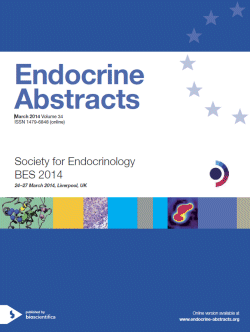Poster Presentations
Clinical biochemistry
ea0034p31 | Clinical biochemistry | SFEBES2014
Effects of light at night and rotating shift on circadian pattern of neuroendocrine chronomolecules
Anjum B , Verma Narsingh , Tiwari Sandeep , Singh Ranjana , Mahdi Abbas
ea0034p32 | Clinical biochemistry | SFEBES2014
Limitations of dexamethasone suppression tests for Cushing's disease: a reminder!
Bejinariu Emanuela , Soo Shiu-Ching , Banerjee Ritwik
ea0034p33 | Clinical biochemistry | SFEBES2014
Are we investigating and managing hyponatremia in hospitalised patients properly: a re-audit
Pearson Laura , Rao Ranganatha , De Parijat
ea0034p34 | Clinical biochemistry | SFEBES2014
A routine combined LC–MS/MS assay for male androgens
ea0034p35 | Clinical biochemistry | SFEBES2014
Urinary kisspeptin as a novel marker of pregnancy
Comninos Alexander , Jayasena Channa , Narayanaswamy Shakunthala , Abbara Ali , Nijher Gurjinder , Cheema Mansimran , Malik Zainab , Ghatei Mohammad , Bloom Stephen , Dhillo Waljit
ea0034p36 | Clinical biochemistry | SFEBES2014
The effects of climate on the incidence of thiazide diuretic induced hyponatraemia in the UK
Redford Christopher , Skinner Thomas , Rys Andrzej , Smith Jamie
ea0034p37 | Clinical biochemistry | SFEBES2014
Generation of a long acting GCSF for treatment of neutropenia and stem cell harvest
Alshehri Abdulrahman , Ross Richard , Wilkinson Ian
ea0034p38 | Clinical biochemistry | SFEBES2014
Hypercalcaemia referrals from primary care: a retrospective audit
Maghsoodi Negar , Moniz Caje , Vincent Royce
ea0034p39 | Clinical biochemistry | SFEBES2014
Development of a LC–MS/MS method for the measurement of serum 17-hydroxyprogesterone during the follicular and luteal phases of the menstrual cycle
Hill Charlotte , Davison Andrew
ea0034p40 | Clinical biochemistry | SFEBES2014
Audit on short synacthen test: are 30 and 60 min samples necessary?
Khalid Yasmeen , Kearney Edward , Joseph Stonny
ea0034p41 | Clinical biochemistry | SFEBES2014
A comparison of calculated bioavailable testosterone with calculated free testosterone
Tesh David , Davies Timothy , Levy Miles , Howlett Trevor
ea0034p42 | Clinical biochemistry | SFEBES2014
Urinary 3-methoxytyramine as a biomarker of phaeochromocytoma and paraganglioma tumours
Neophytou Christina , Darch Sarah , Gill Jasdeep Singh , Hancock Maggie , Meeran Karim , Palazzo Fausto , Tan Tricia
ea0034p43 | Clinical biochemistry | SFEBES2014
Evaluation of the efficacy of transdermal delivery of chloroquine on Plasmodium berghei-infected male Sprague–Dawley rats: effects on blood glucose and renal electrolyte handling
Sibiya Happiness , Serumula Metse , Musabayane Cephas T
ea0034p44 | Clinical biochemistry | SFEBES2014
Measurement of dexamethasone by LC–MS/MS after a 1 mg overnight dexamethasone suppression test
Debono Miguel , Newell-Price John , Hawley James , Keevil Brian
ea0034p45 | Clinical biochemistry | SFEBES2014
Serum 5HIAA: a better biomarker than urine for detecting and monitoring neuroendocrine tumours?
Adaway Joanne , Dobson Rebecca , Walsh Jennifer , Cuthbertson Daniel , Monaghan Philip , Valle Juan , Devlin Neil , Keevil Brian
ea0034p46 | Clinical biochemistry | SFEBES2014
High testosterone? Look again!
Babiker Tarig , Perry Mandy , McDonald Timothy , Brooke Antonia , O'Connor John
ea0034p47 | Clinical biochemistry | SFEBES2014
Vitamin D status in patients visiting a large teaching hospital
Hirany Shaina , Firan Mihail , Hashim Ibrahim
ea0034p48 | Clinical biochemistry | SFEBES2014
Development of a whole blood assay for the LC–MS/MS measurement of 5-hydroxyindole acetic acid
Armitage Suzanne , Adaway Joanne , Keevil Brian
ea0034p49 | Clinical biochemistry | SFEBES2014
Do we need method specific cortisol cut off limits for dynamic function tests?
Braha Kate , Phillips Suzannah , Dutton John , Milan Anna
ea0034p50 | Clinical biochemistry | SFEBES2014
Reference ranges for salivary steroid measurement during short synacthen tests
Shotton Rohan , Perogamvros Ilias , Keevil Brian , Monaghan Philip , Trainer Peter , Higham Claire
ea0034p51 | Clinical biochemistry | SFEBES2014
Hyponatraemia prior to discharge from hospital after a general medical admission is associated with a significantly increased risk of readmission within 28 days
Solanki Pratik , Whitelaw Benjamin , Leong Christine , Miell John , Aylwin Simon




